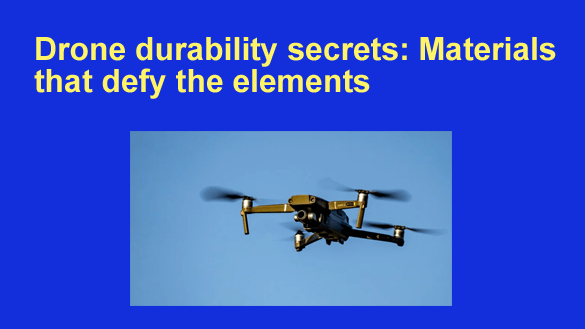 In the ever-expanding area of aerial technology, drones have gained significant traction due to their diverse applications, from photography and surveillance to package delivery.
In the ever-expanding area of aerial technology, drones have gained significant traction due to their diverse applications, from photography and surveillance to package delivery.
Yet, amidst these soaring ambitions, the drone’s ability to endure harsh environmental conditions remains a paramount concern. For instance, Skydio X10 has the best sensors for a drone this small, piloted by the most advanced AI in the sky.
This article delves into the critical aspect of drone durability, exploring the materials that empower these flying marvels to withstand the elements.
A Foundation of Resilience
The longevity of a drone begins with the materials used in its construction. Engineers have come to rely on a combination of lightweight but robust substances, such as carbon fiber, for the frame.
Carbon fiber’s strength-to-weight ratio is nothing short of impressive. It provides the necessary structural integrity while keeping the drone’s overall weight at a minimum, a crucial factor for efficient flight.
Weather-Resistant Exteriors
For instance, drones from Skydio X10 often find themselves navigating through unpredictable weather conditions. Rain, snow, and dust can pose significant challenges.
To counteract these environmental hazards, manufacturers employ materials with natural weather-resistant properties, such as polymers and composites. These materials are adept at repelling moisture and protecting internal components from water damage.
The Power of Polycarbonate
Polycarbonate, renowned for its exceptional properties, stands out as the preferred material for drone exteriors. Its remarkable impact resistance safeguards the delicate inner components from external forces and contributes to the drone’s overall durability.
The inherent lightweight nature of polycarbonate minimizes the burden on the drone, enabling enhanced agility and extended flight times. Furthermore, its transparency is pivotal in facilitating the unobstructed functionality of sensors and cameras, which is crucial for the drone’s navigation and data collection capabilities.
In summary, polycarbonate’s unique combination of strength, lightness, and transparency establishes it as an invaluable choice for safeguarding and enhancing the performance of drones.
Robust Circuitry
In drone design, robust circuitry serves as the backbone of reliable operation. Beyond the superficial facade, the internal electronic infrastructure must endure the demanding trials of aerial navigation.
Engineers meticulously construct circuit boards and components to conform to stringent military-grade specifications, enhancing their resilience. These electronic elements are fortified to withstand the onslaught of electromagnetic interference, a vital fortification ensuring unwavering functionality in the face of adverse environmental circumstances.
This dedication to ruggedized electronics ensures that drones can steadfastly fulfill their missions, whether soaring through challenging terrains or enduring turbulent weather conditions, exemplifying the pinnacle of engineering excellence in unmanned aerial systems.
The Battle Against Corrosion
In the relentless battle to safeguard sensitive drone electronics, moisture is not the sole adversary. Corrosion emerges as a formidable threat, capable of inflicting significant damage.
To thwart this insidious foe, manufacturers deploy specialized corrosion-resistant coatings on essential components. These coatings function as a robust shield, steadfastly defending against the insidious forces of circuitry decay induced by prolonged contact with moisture and environmental contaminants.
By fortifying critical parts with these protective layers, drones are endowed with increased resilience, ensuring their continued operational reliability amidst challenging and corrosive environments. In essence, the fight against corrosion is a pivotal aspect of preserving the functionality and longevity of modern drone technology.
Resilient Batteries
The power source of a drone, the battery, is a crucial player in ensuring durability. Lithium-polymer and lithium-ion batteries have become the standard for their high energy density and longevity.
However, advancements continue to be made in battery technology to improve durability, such as the development of solid-state batteries that are less prone to damage.
Extreme Temperature Tolerance
Drones must operate in various temperatures, from sweltering deserts to freezing mountain peaks. The materials used must be able to withstand these extremes.
Many drones are equipped with thermal management systems that dissipate excess heat or provide insulation against the cold, thus safeguarding sensitive components.
Impact-Resistant Propellers
Propellers are vital for drone flight but also vulnerable to damage from collisions or rough landings. Engineers have turned to materials like nylon and carbon fiber for propeller construction, known for their durability and ability to absorb impacts without compromising performance.
Vibration Dampening
The constant vibrations generated during drone flight can affect delicate equipment, affecting performance and longevity. Engineers incorporate vibration-dampening materials and techniques into the drone’s design to counteract this, ensuring that internal components remain stable and secure.
Conclusion
Drone manufacturers relentlessly pursue innovation and functionality and recognize that durability is a cornerstone of success. The materials and technologies employed in drone construction continue to evolve, allowing these aerial marvels to endure and thrive in challenging environmental conditions.
From the robust frame of carbon fiber to the weather-resistant exteriors of polycarbonate, every aspect of a drone’s design plays a vital role in its ability to defy the elements. As technology advances and materials become even more resilient, the future promises drones that can soar through the harshest conditions, expanding their capabilities and applications even further.